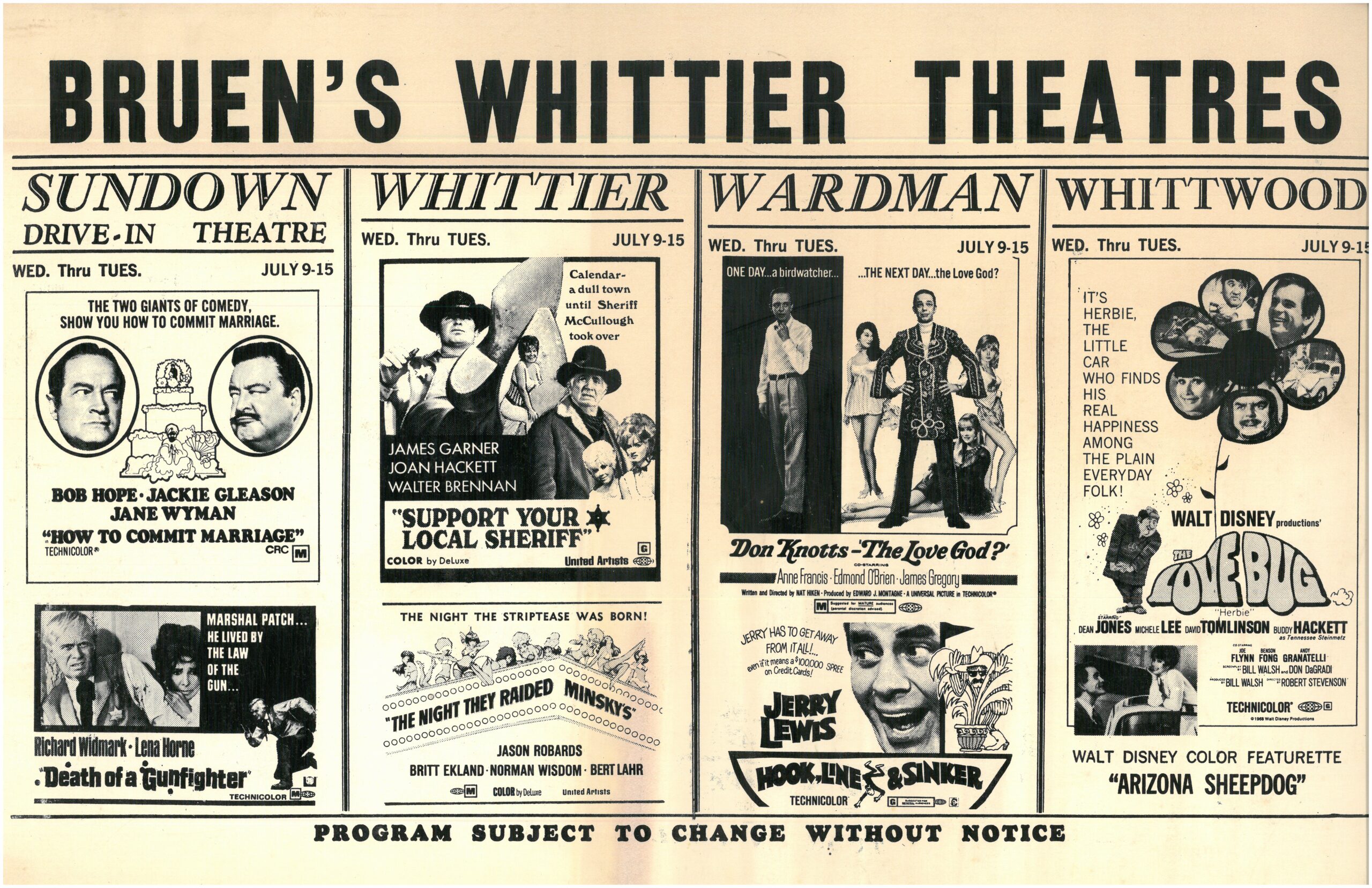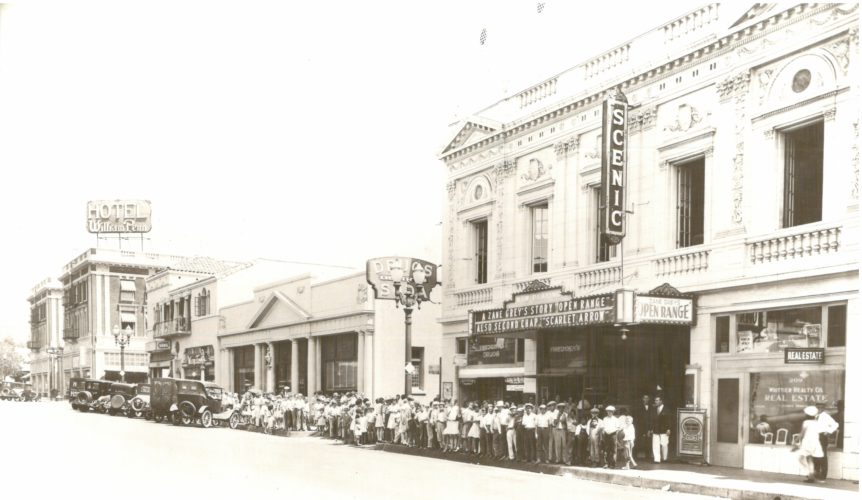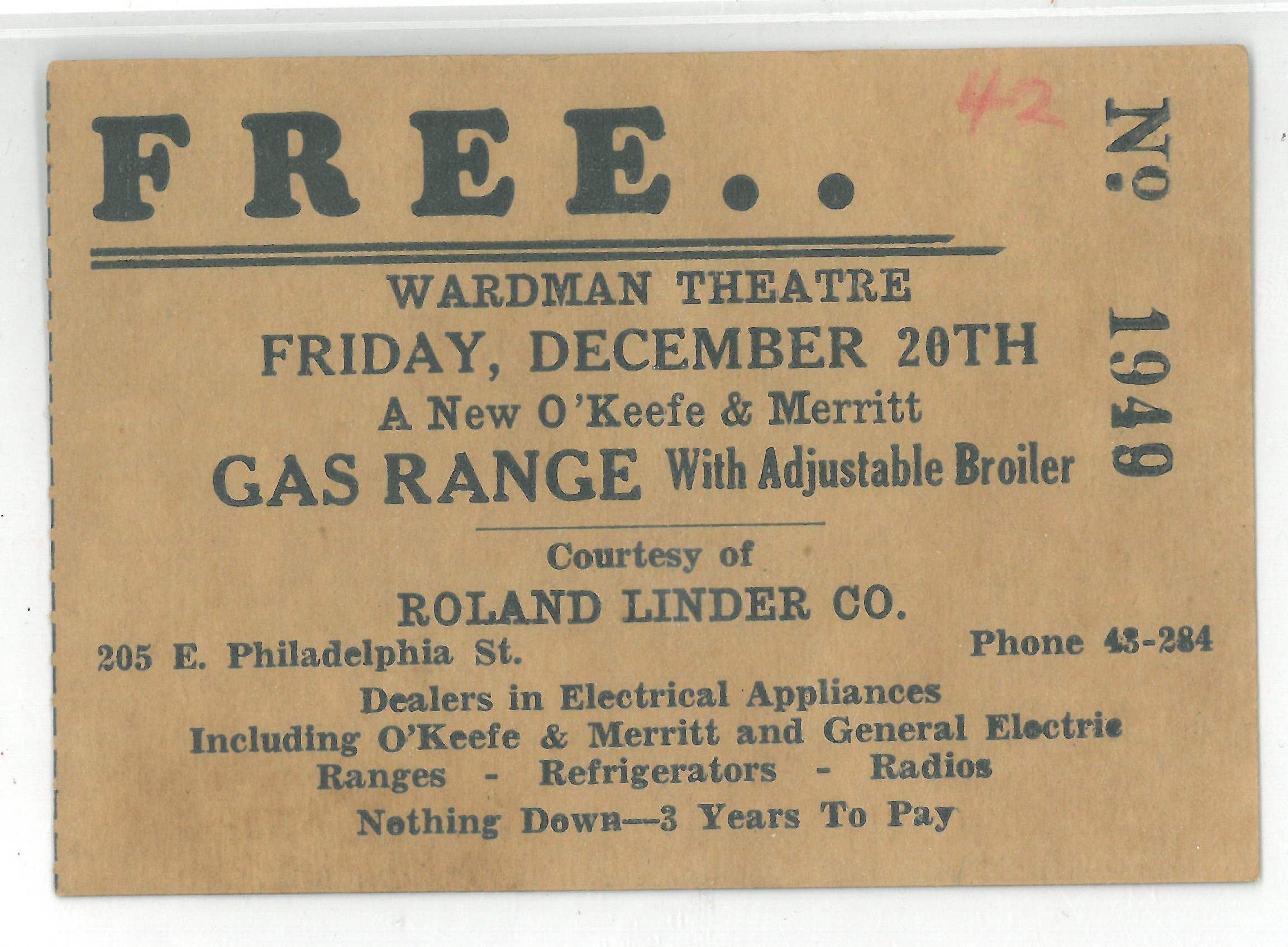
Adapted from the Whittier Museum Gazette articles from April 2022, March 2023 & April 2023 by Nicholas Edmeier, Curator.
An exciting point in any early 20th century city’s life was the arrival of its first movie theater, followed by the building of bigger and better rivaling theaters. Before anything we would recognize as a “movie theater” in Whittier, most film showings during the 1910s started as pop-up moving-picture shows that were shown any place people could gather: churches, community centers, school auditoriums, etc. Most of the these were traveling film companies charging a nickel to see a 15 minute or shorter silent movie.
Before the Whittier First Christian congregation moved in 2019, they showed the 1925 adaption of The Phantom of the Opera in the sanctuary, accompanied by music on the church organ. Those of you who were able to attend were very lucky! This is exactly how movies would have been shown during the 1910s.
During this time, a lot of playhouses adapted by installing movie screens. The Pantages Theatre in Hollywood was a movie theater until 1977. This is partially why you see so many vintage movie theaters built in a dramatic/operatic style with a functional stage, mezzanine levels and box seats. During that period, live stage shows and moving-pictures shared the same performance space.
The task of putting all the historic Whittier movie theaters in order has been a daunting task, given that many of the newspaper clippings before the 1920s did not contain opening and location information. As much as I would like to write in detail about every single theater, research is still on-going to learn how each theater was managed, the types of entertainment they showed, any notable acts or films, and exactly how long they were in business. Hopefully by next year, I’ll be able to do a complete lecture on Whittier’s movie theater history. In the meantime, I hope you will enjoy this overview of the movie theaters that were present in early Whittier.
The first “movie theater” in Whittier was the Family Motion Picture Theatre, built sometime around 1905, with a 300 seat capacity. In its location today is the gray and white Colonial styled building north of Whittier Village Cinemas on Greenleaf Avenue. Admission cost was 10 and 15 cents for adults, and 5 cents for children. The Family Theatre was owned and operated by the Keipp family, who would go on to manage almost all the theaters in Whittier before 1930. When looking through the Family Theatre advertisements in the Whittier News, my attention was caught by a 1911 headline, “local boys in moving picture,” in which several boys from Whittier were in the silent Western drama Fighting Blood. Even then, Whittier was part of movie making. The Family Theatre was closed/demolished roughly around 1916, but more research is currently in the works.
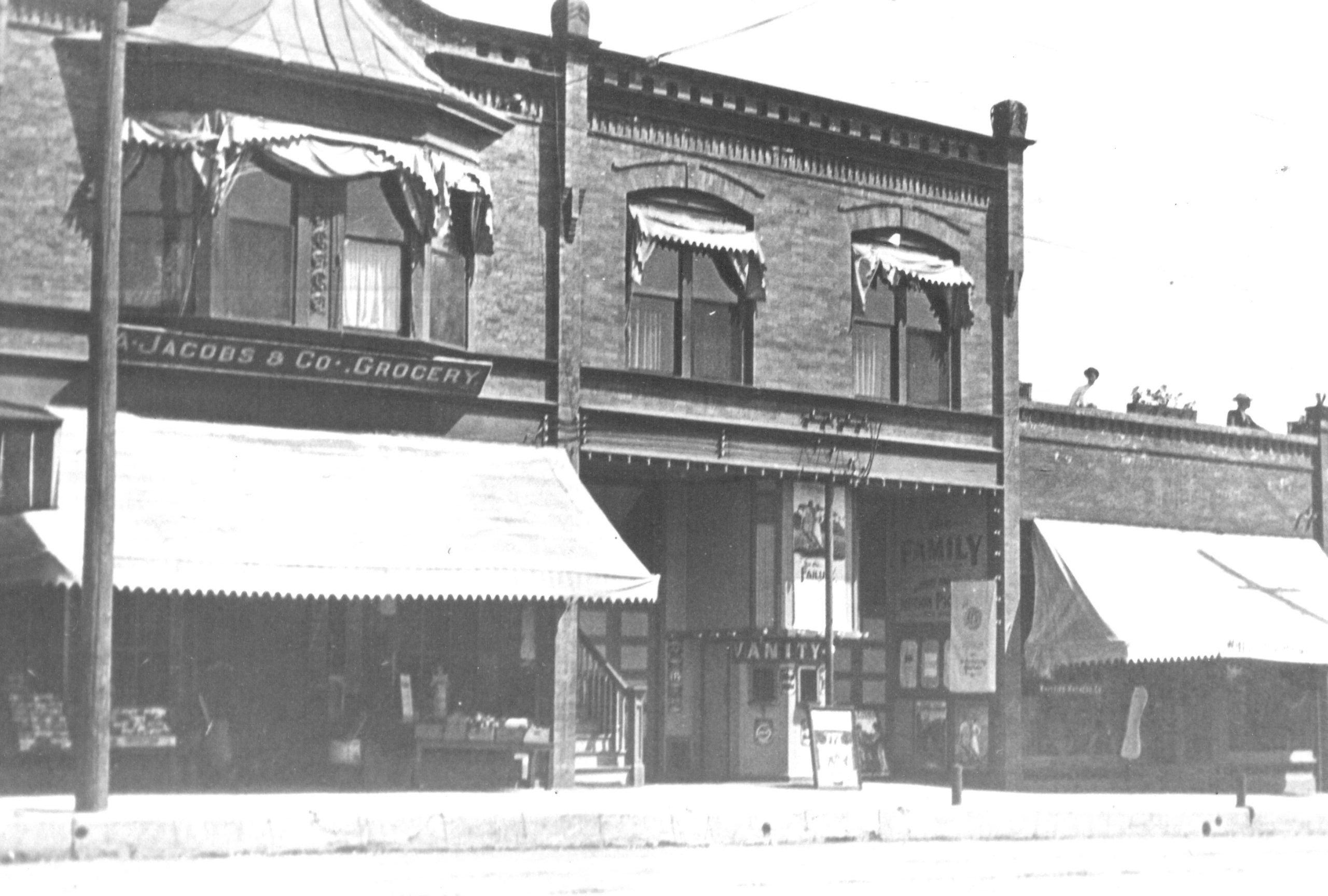
Above: a recently discovered photo of the Family Theatre in Whittier alongside Jacobs & Co, Grocery. You can make out the large "Family Theatre" banner next to the ticket counter.
The Optic Theatre was the second movie theater built in Whittier across the street from the Family Theatre. It opened on January 31st, 1910 where Turnbull's Tavern is today. Like many early movie theaters, the Optic’s main attractions included nickelodeons, color photograph shows, vaudeville and various stage performances. The theater would close in 1915 to become a hardware store.
For those who are unfamiliar with nickelodeons and vaudeville, they were the most popular forms of entertainment during the early 1900s. Nickelodeons were short movies that would last from 15 to 30 minutes and were accompanied by piano/organ. Vaudeville was a live performance act accompanied by live music that featured: comedy acts, singing, dancing, juggling, acrobatics, illusion, ventriloquism, puppetry, etc. Vaudeville acts were popular beginning in the early 1800s, until finally fading out during the 1930s after the release of “talking pictures.”
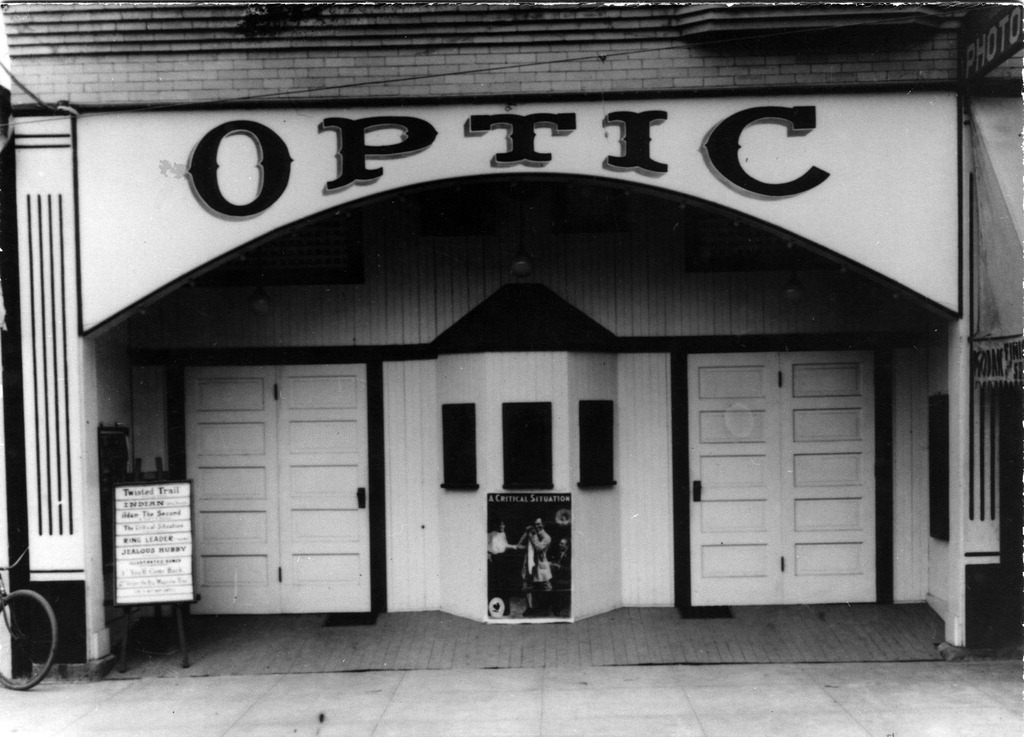
Above: the Optic Theatre in 1910. The poster left of the ticket booth in the center is for A Critical Situation, that was released in February of 1910. The board lists the cast for Twisted Trail, a D.W. Griffith film from March of 1910. Films by Griffith would be regularly shown in Whittier since they were some of the most popular silent films produced. Vaudeville acts were the most popular type of entertainment during this period. One of the Optic Theatres most popular vaudeville acts was performed by Anna Robinson and her magician husband, Frederick Palmer. The two performed in Whittier and dozens of theaters in Los Angeles, in shows titled "Palmer and Robinson, The Sorcerer and the Soubrette" and "The Maid and the Mountebank."
The next theater to open was the Berry-Grand Theater in July 1913. The opening was delayed by a week due to a late delivery of the theater seats. Today, the location is occupied by the canopy covered shops a half block east of the Starbucks on Philadelphia Street. At the time, the Berry-Grand was noted for being one of “the best ventilated and conveniently arranged picture houses in Southern California.”
The Optic and Family Theatres would eventually fade away from the newspaper listings around 1916 after another theater was built: the Gale. Originally where Victory Outreach Church stands, the Gale Theatre had its grand opening on June 5, 1916. The Whittier News reported that over 1,000 people attended the two-day opening. Unlike the previous theaters, the Gale received a lot of pre-opening publicity, including two full pages in the Whittier News advertising all the local businesses who had contributed to its construction.

Above: it’s been a challenge to find photos taken of the Gale Theater building. The only image that’s currently been found is from the 1916 Whittier News documenting its opening. Sadly the photo was placed between the paper creases, resulting in an awkward reconstruction scan. The Gale was described to be a white painted brick building with a tin roof and skylights, and a green electric “Gale” sign over the entry archway.
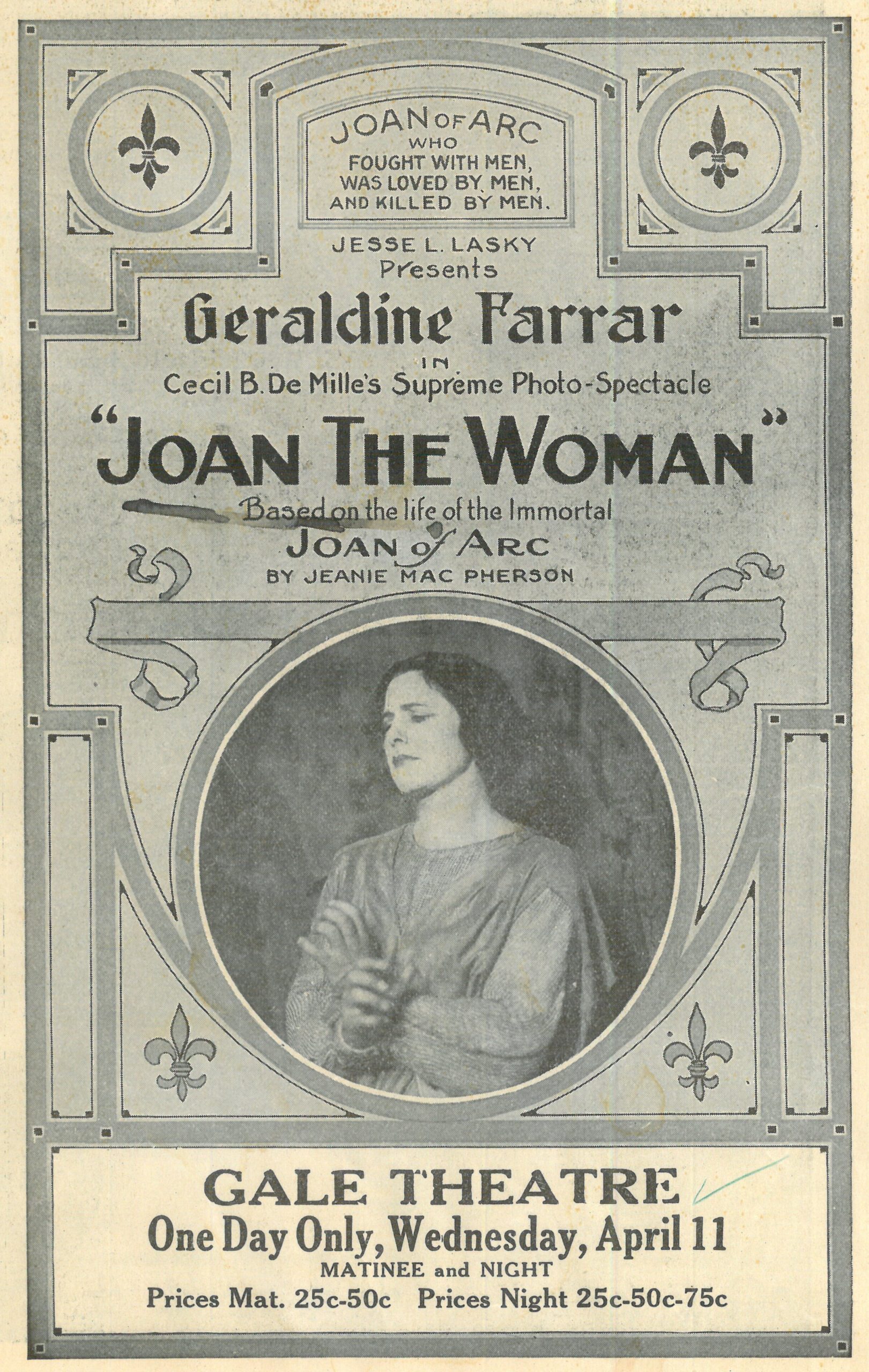
Above: We were fortunate to discover in our archives a Gale Theatre playbill from 1916 for a silent film Joan the Woman, about the life of Joan of Arc, with Geraldine Farrar as the title character. The film was directed by Cecil B. DeMille, acknowledged as the “Founding Father of American Cinema.” During the 1910s to the 1950s, it was common for mainstream films to have playbills just like a regular play with the entire cast listed and photos from the film.
The Gale would enjoy several years of success alongside the Berry-Grand Theatre. The Berry-Grand did suffer business hardships after the manager was sued for showing an illicit film, Hypocrites from 1915, that was not approved by the local board of censorship. The case was litigated in the Los Angeles Superior County Superior Court.
Eventually the owners of the Gale Theatre decided to sell the business in 1922. The new owner would attempt to revitalize the business by renaming it the Strand Theatre and moving it to another building. Today the location is Marco Polo Pizza on Philadelphia Street. The Whittier News distinctly called it a “beautiful, little theater” and described it as a “Egyptian picture house.” Egyptian style decorating was a popular design for theaters after the discovery of Tutankhamun’s tomb and the Grauman's Egyptian Theatre in Hollywood. The Strand would endure a few years longer before it closed just before 1930 and its equipment shipped to another theater company in Long Beach.
The first true movie palace in Whittier was the Scenic Theatre, opening on June 29, 1921. See pages 1 and 6 for photos of the Scenic Theatre. The Scenic was located where Kalaveras Mexican restaurant is today on Philadelphia Street. The theater was built with a capacity for 1,500 guests that included two mezzanine levels and boasted comfort and excellent views of the stage. The Scenic was built no differently than an opera house with rooms designated for lounging, manager’s offices, staff quarters, men’s and women’s parlor rooms, smoking rooms, and equipment rooms. All that was missing was a Phantom hiding beneath the stage!
In 1936, the Scenic was renamed the Roxy and remained in operation until 1968. It was noted in a 1968 Whittier News that the Roxy was losing business because it showed mainly foreign films and films designated for adults. The building remained unused until it was destroyed by an arson fire in 1971. Ten days prior, an attempt to burn the building was unsuccessful. Whoever set both fires was never brought to justice.
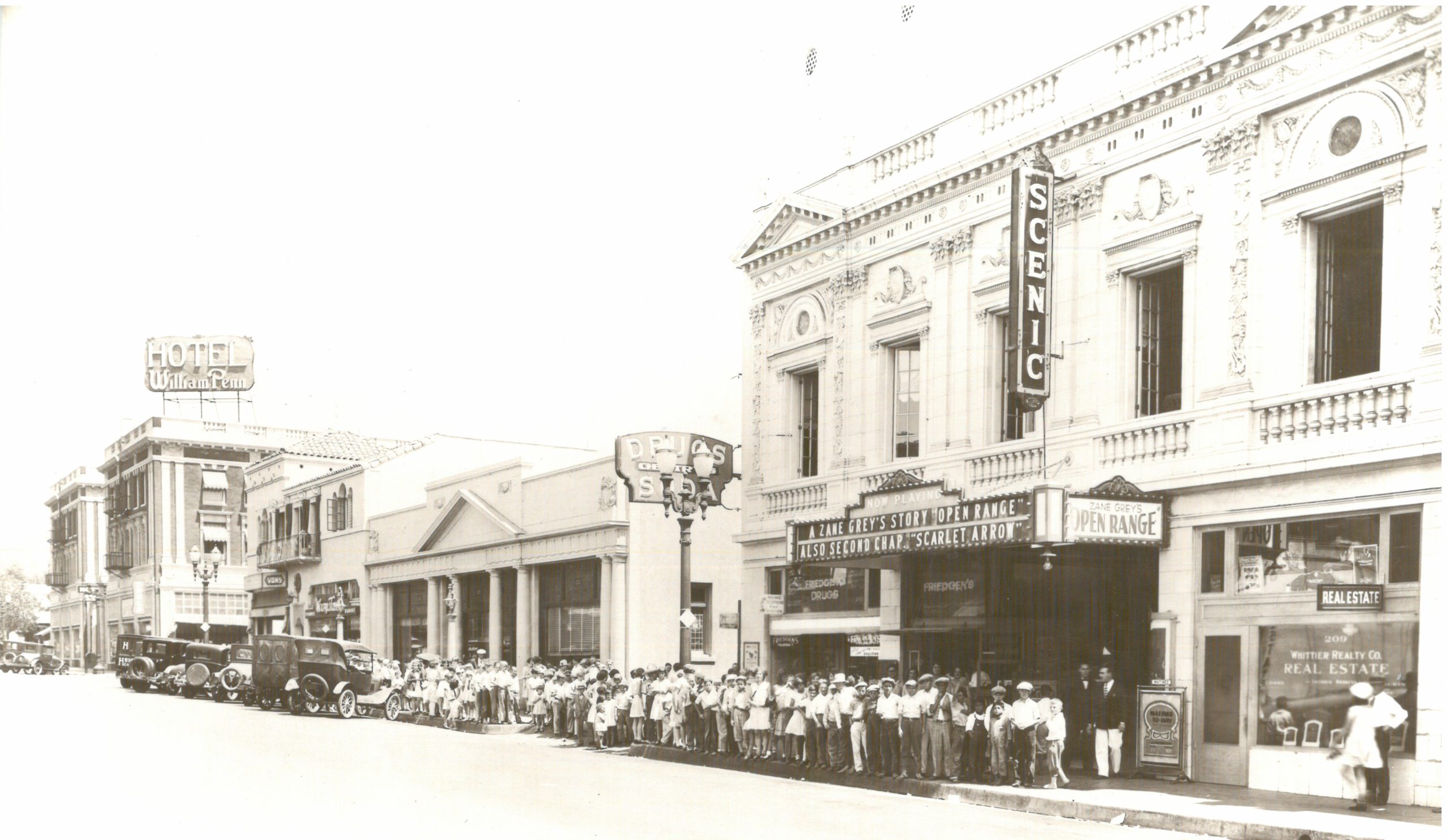
Above: photograph of the Scenic Theatre during the 1940s. The completed building cost was over $150,000, including the installation of a massive pipe organ that cost $20,000. To the left you can see the large William Penn Hotel sign and building. A large crowd is gathered outside the theater, and it mainly consists of children, especially young boys waiting to see the latest installments of the serials "Open Range" and "The Scarlet Arrow."
Both the Whittier Theatre on Whittier Boulevard, opening in 1929, and the Wardman Theatre on Greenleaf, opening in 1932, were designed by local architect, David S. Bushnell, but with different styles. The Whittier Theatre was designed in Spanish Revival style, while the Wardman Theatre was American Art Deco. Despite their differences, both movie theaters would become iconic Whittier landmarks.
There is no doubt many who remember this iconic building with its tower overlooking Whittier Blvd.; supposedly sometimes used by Whittier PD to watch for speeding cars. The location was on the south side of the street where Whittier meets Hadley. The old address for the building was 1410 W. Whittier Blvd.
Prior to the theater being built, the property was owned and operated by the McNees family as a ranch, where 20 acres of walnuts once grew. The first McNees was Dr. Ralph McNees of Michigan who came to Whittier during the Land Boom of the late 1880s. He moved to Whittier with the intention of changing careers from doctor to rancher and then movie theater owner. His reason? He didn’t like being woken up in the middle of the night for emergencies, especially during Michigan winters!
First called McNees Theatre, over the years it was also known as Warner Bros. Whittier Theatre, Bruen’s Whittier Theatre, and simply, the Whittier Theatre. The auditorium consisted of about 1,000 seats that included the floor level and small private box seats along the walls. The boys of the Whittier State School often walked over to the theater during the 1930s and 40s for free shows courtesy of Hugh Bruen.
The Historic American Buildings Survey had this to say about the Whittier Theatre:
The Whittier Theatre was the largest and most elaborate movie theater complex in Whittier. It was significant as an example of a local architect's interpretation both of the prevailing trend toward grand-scale movie palace construction and of the enormous popularity of the Spanish colonial architectural style in Southern California in the early 20th century. It was one of few motion picture theaters to have incorporated 'atmospheric' effects in the auditorium lighting to simulate sunset, moving clouds, and a starlit sky.
What set the Whittier Theatre apart from the theaters in Uptown is that it was outside the city limits until 1946 and could show movies on Sundays, which was not allowed in Uptown. There was an article in the Whittier News from March 8, 1928, that the Strand and Scenic Theatres petitioned the city to allow all Whittier theaters to open on Sundays.
It’s common knowledge to most residents that the Whittier Theatre suffered extensive damage due to the Whittier Narrows Earthquake in 1987. Despite attempts to save the theater and renovate it as a new business, it was completely demolished in the 1990s. The theater was located on the southeast corner of Whittier Blvd. and Hadley St. where a Walgreens drugstore is located today. Recall that the Wardman Theatre also suffered damage during the 87 earthquakes, resulting in the closure of the Pussycat Theater that opened in the 1970s. The current Whittier Village Cinemas business opened in 1990 with eight additional screening rooms built. Keep in mind that every Whittier theater that was previously discussed had only one screening room.
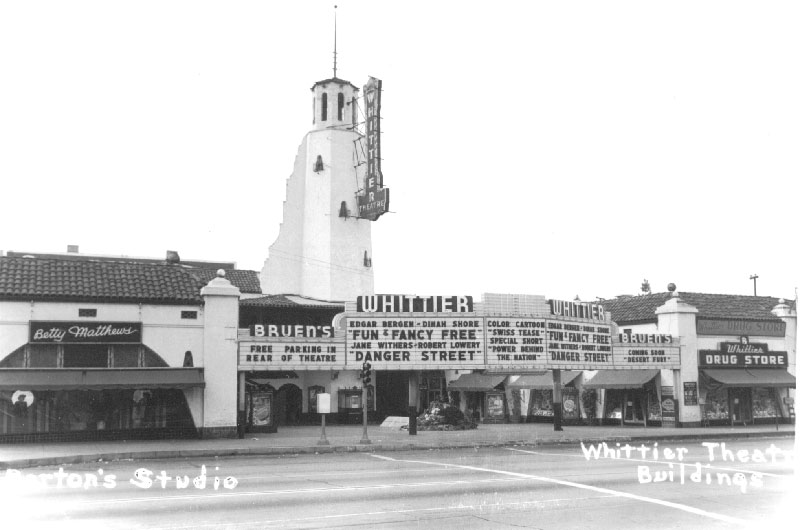
Above: photograph of Whittier Theatre located on Whittier Blvd. Originally opening on July 31, 1929, the auditorium consisted of 1,000 seats and small private box seats along the walls. Prior to the movie theater being built, the property was owned by the McNees family as a ranch, where 20 acres of walnuts once grew.
Anyone who lives in Whittier knows the only place to see a movie locally is Whittier Village Cinemas, located at 7038 Greenleaf Avenue. This year (March of 2023) the building will celebrate its 91st anniversary as a “movie house” since opening in 1932. During its early life, the building was called the Wardman Theatre after the original owner/operator. After several ownership changes, it was re-christened Whittier Village Cinemas in 1990. The Wardman Theatre (Whittier Village Cinemas) is the last "original theater" still standing in Whittier.
The Wardman Theatre was built by local businessman and philanthropist, Aubrey Wardman. Wardman had finished construction of the Hoover Hotel in 1930, then decided to build a new, “upscale” movie theater in Whittier across the street from the hotel. The theater cost Wardman close to $100,000 - a considerable sum for the time. Wardman specified that all materials, labor and design be locally sourced - the same as the Hoover Hotel. Both projects pumped about $365,000 into the Whittier economy during one of the worst financial periods in American history.
The finished result was a modern movie palace designed in the popular art deco style that would accommodate over 900 patrons in a one room theater, with shops along the exterior.
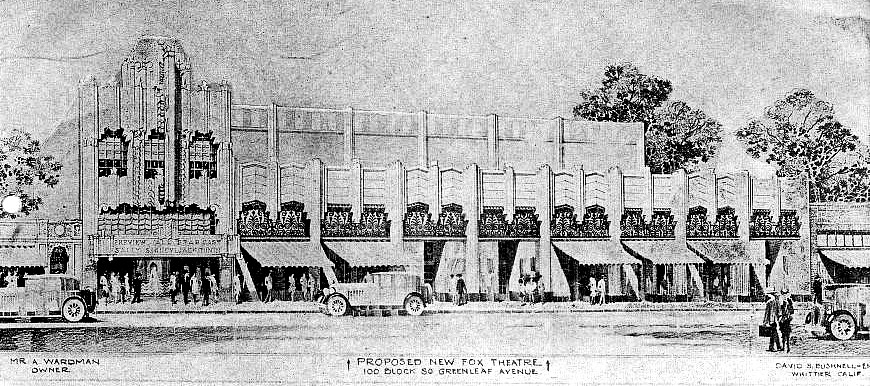
Above: a 1930s sketch of the proposed Wardman Theatre from David Bushnell's office that appeared in the Fox West Coast "Now" magazine.
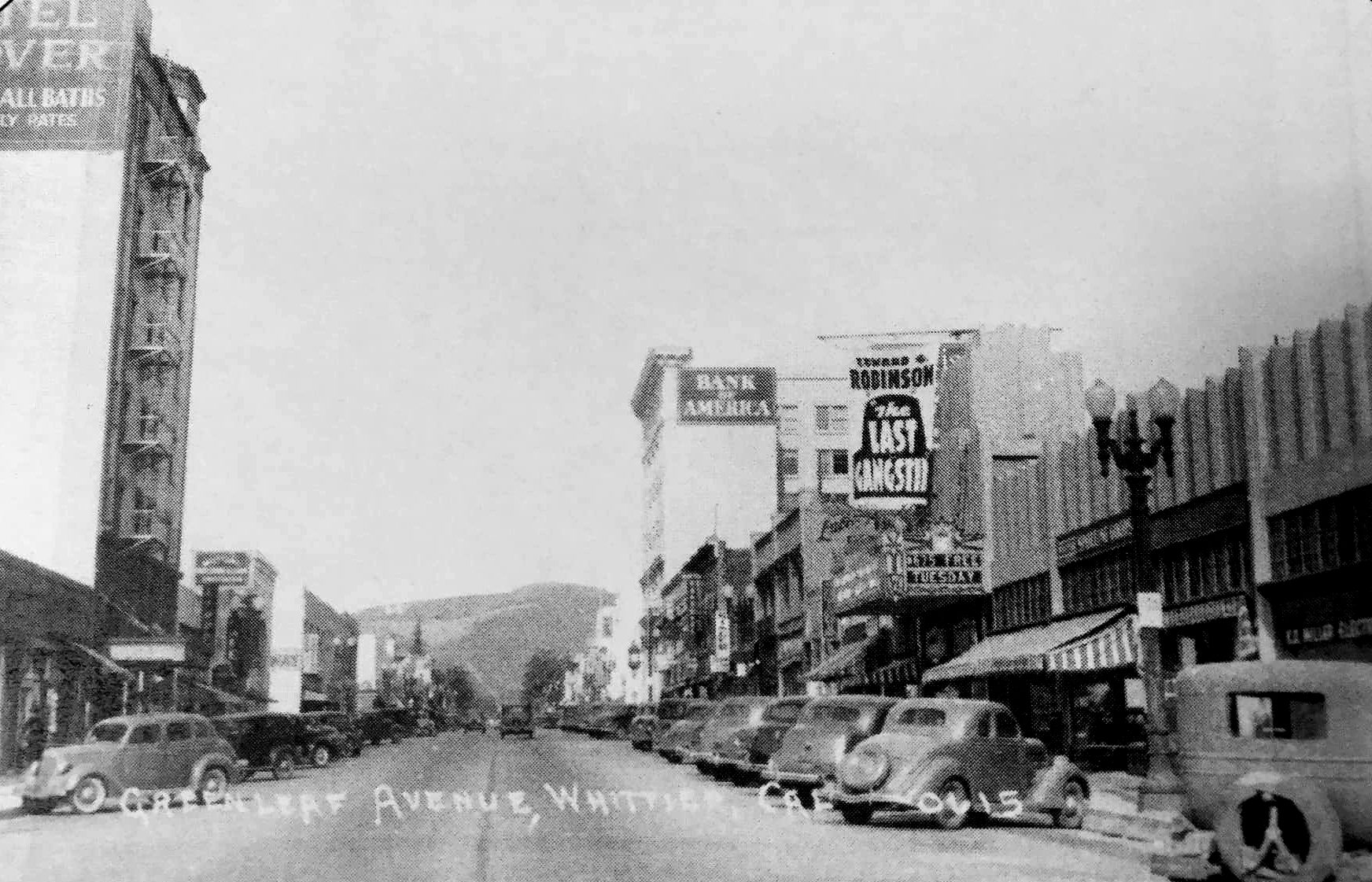
Above: an ad for the upcoming opening that appeared in the March 12, 1932 issue of the Whittier News. The bottom figure is a 1937 photograph of Greenleaf Ave. looking north with the theater on the righthand side.
Ownership of the Wardman would change hands several times. The most remembered would be during the 1970s when the building became a Pussycat Theater. The City of Whittier fought the owners of the Pussycat Theater in court for 10 years until the 1987 earthquake helped shut the Pussycat down. The Whittier Village Cinemas, a family-oriented, multi-screening room theater, opened in 1990. Today, it is formally known as Starlight Whittier Village.
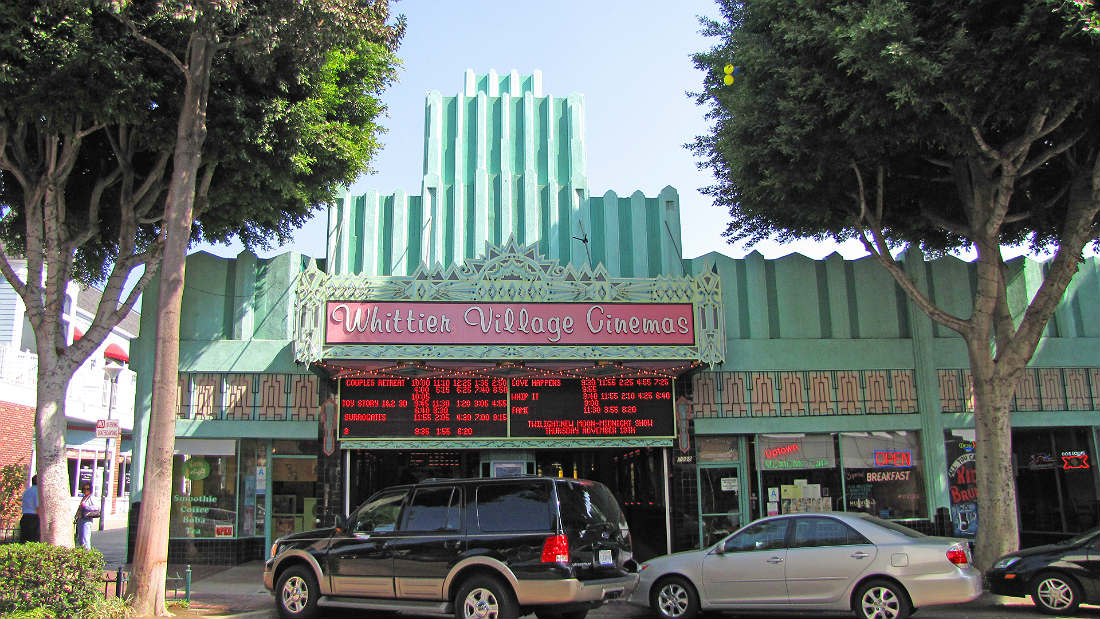
Above: the Wardman Theatre today as Whittier Village Cinemas retains most of its original exterior design, with the exception of color, its original marquee and several decorative features.
In February of 2023, the Whittier Museum was approached by documentary filmmaker, Kyle Macias, producer of the documentary series Whittier’s Everyday Life. The series focuses on unique people and stories in the city of Whittier. Macias asked for our assistance in doing an episode on the Wardman Theatre. The documentary gave us the opportunity to reevaluate the theater’s history and to see some of the older parts of the building still surviving that are off-limits to guests. The episode is now available for purchase on Amazon Prime Video.
